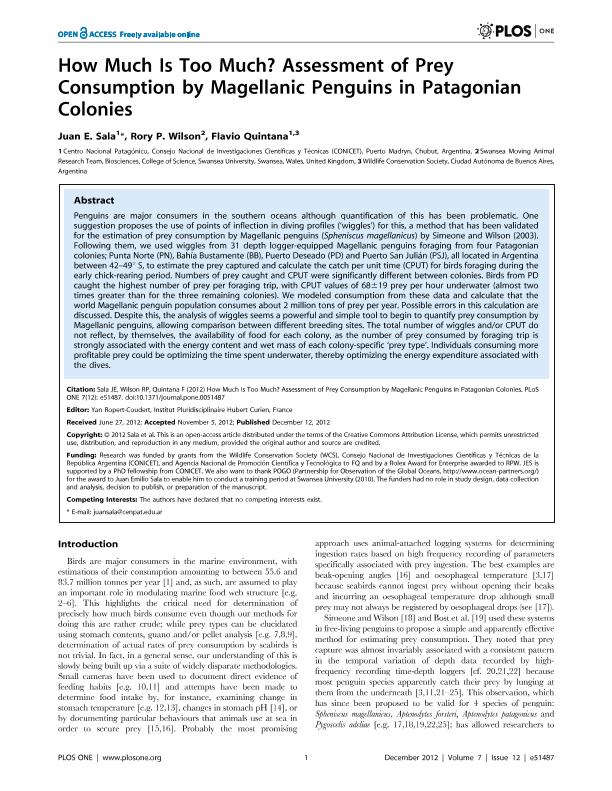Mostrar el registro sencillo del ítem
dc.contributor.author
Sala, Juan Emilio

dc.contributor.author
Wilson, Rory P.

dc.contributor.author
Quintana, Flavio Roberto

dc.date.available
2020-04-03T15:48:22Z
dc.date.issued
2012-12-12
dc.identifier.citation
Sala, Juan Emilio; Wilson, Rory P.; Quintana, Flavio Roberto; How much is too much? Assessment of prey consumption by Magellanic penguins in Patagonian colonies; Public Library of Science; Plos One; 7; 12; 12-12-2012; 1-13; e51487
dc.identifier.issn
1932-6203
dc.identifier.uri
http://hdl.handle.net/11336/101820
dc.description.abstract
Penguins are major consumers in the southern oceans although quantification of this has been problematic. One suggestion proposes the use of points of inflection in diving profiles (´wiggles´) for this, a method that has been validated for the estimation of prey consumption by Magellanic penguins (Spheniscus magellanicus) by Simeone and Wilson (2003). Following them, we used wiggles from 31 depth logger-equipped Magellanic penguins foraging from four Patagonian colonies; Punta Norte (PN), Bahía Bustamente (BB), Puerto Deseado (PD) and Puerto San Julián (PSJ), all located in Argentina between 42-49° S, to estimate the prey captured and calculate the catch per unit time (CPUT) for birds foraging during the early chick-rearing period. Numbers of prey caught and CPUT were significantly different between colonies. Birds from PD caught the highest number of prey per foraging trip, with CPUT values of 68 ± 19 prey per hour underwater (almost two times greater than for the three remaining colonies). We modeled consumption from these data and calculate that the world Magellanic penguin population consumes about 2 million tons of prey per year. Possible errors in this calculation are discussed. Despite this, the analysis of wiggles seems a powerful and simple tool to begin to quantify prey consumption by Magellanic penguins, allowing comparison between different breeding sites. The total number of wiggles and/or CPUT do not reflect, by themselves, the availability of food for each colony, as the number of prey consumed by foraging trip is strongly associated with the energy content and wet mass of each colony-specific ´prey type´. Individuals consuming more profitable prey could be optimizing the time spent underwater, thereby optimizing the energy expenditure associated with the dives.
dc.format
application/pdf
dc.language.iso
eng
dc.publisher
Public Library of Science

dc.rights
info:eu-repo/semantics/openAccess
dc.rights.uri
https://creativecommons.org/licenses/by-nc-sa/2.5/ar/
dc.subject
Prey Consumption
dc.subject
Foraging Succes
dc.subject
Foraging Effort
dc.subject
Magellanic Penguin
dc.subject
Spheniscus Magellanicus
dc.subject
Patagonia
dc.subject
Conservation
dc.subject.classification
Ecología

dc.subject.classification
Ciencias Biológicas

dc.subject.classification
CIENCIAS NATURALES Y EXACTAS

dc.subject.classification
Conservación de la Biodiversidad

dc.subject.classification
Ciencias Biológicas

dc.subject.classification
CIENCIAS NATURALES Y EXACTAS

dc.subject.classification
Zoología, Ornitología, Entomología, Etología

dc.subject.classification
Ciencias Biológicas

dc.subject.classification
CIENCIAS NATURALES Y EXACTAS

dc.title
How much is too much? Assessment of prey consumption by Magellanic penguins in Patagonian colonies
dc.type
info:eu-repo/semantics/article
dc.type
info:ar-repo/semantics/artículo
dc.type
info:eu-repo/semantics/publishedVersion
dc.date.updated
2019-03-27T14:53:20Z
dc.journal.volume
7
dc.journal.number
12
dc.journal.pagination
1-13; e51487
dc.journal.pais
Estados Unidos

dc.journal.ciudad
San Francisco
dc.description.fil
Fil: Sala, Juan Emilio. Consejo Nacional de Investigaciones Científicas y Técnicas. Centro Nacional Patagónico; Argentina
dc.description.fil
Fil: Wilson, Rory P.. Universidad de Swansea, Gales, Reino Unido; Reino Unido; Reino Unido
dc.description.fil
Fil: Quintana, Flavio Roberto. Consejo Nacional de Investigaciones Científicas y Técnicas. Centro Nacional Patagónico; Argentina
dc.journal.title
Plos One

dc.relation.alternativeid
info:eu-repo/semantics/altIdentifier/doi/http://dx.doi.org/10.1371/journal.pone.0051487
dc.relation.alternativeid
info:eu-repo/semantics/altIdentifier/url/https://journals.plos.org/plosone/article?id=10.1371/journal.pone.0051487
Archivos asociados
